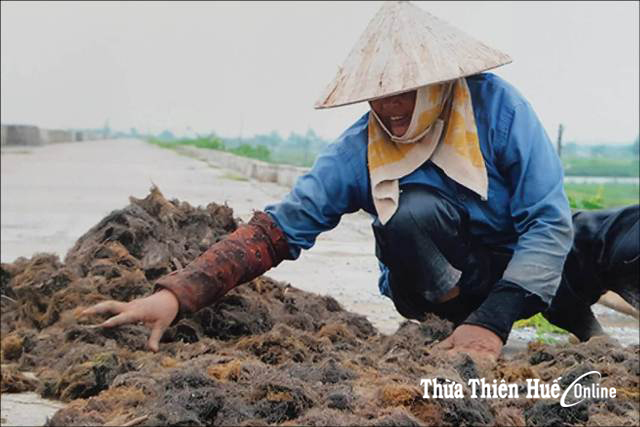
Seaweed brings many economic benefits to Phu An people
As a coastal area, Phu An has many lagoons suitable for the development of seaweed. This species is associated with the life of people in Phu An commune. Back when people did not fully understood the value of seaweed, they would use leftover seaweed as feed for aquaculture. Later, from the curiosity of a few gourmets, dishes such as boiled seaweed, steamed seaweed were gradually processed to become more sophisticated dishes like seaweed salad or seaweed jelly. Now, seaweed has become an ingredient that inspires the women of this coastal area to be creative and discover many new and unique dishes on the occasion of Lunar New Year.
Mrs. Doan Thi Tranh, 65 years old, from An Truyen village recalled: "In my memory, households with many children would make jelly every now and then. The seaweed was aplenty but sugar wasn’t as cheap as it is now. In addition, it took a really long time to make traditional jelly. The seaweed must be exposed to “2 suns and one dew” (two days of sunlight and one night) to have a beautiful violet colour. As the plants grow in the lagoon, they must be washed thoroughly to remove all the moss and snails which cling to them. When cooking, we have to pour the water at the same level with the seaweed, boil many times and then drain with a thin cloth before the jelly sets. That's not to say we also have to prepare the sugar syrup to go with the jelly."
With the promotion of the culinary culture, the nutritional value of seaweed is becoming highly appreciated. Raw ingredients from nature play a vital role in creating dishes for the menu. The people of Phu An have become more appreciative of the precious species that nature has given and use seaweed to create the specific characteristics of coastal cuisine.
Mr. Chau Duc Hoang, Secretary of Phu An Commune Party Committee said: "From March to June (Lunar calendar), the seaweed here grows in layers and layers in the lagoon. Previously, only hardworking people would pick the seaweed and dry it to reserve as feed for aquaculture. Now, if you go to a restaurant, a plate of boiled seaweed is also considered to be a specialty dish. The people of Phu An now also stock seaweed, but to make many delicious dishes for the Lunar New Year.
In season, each Phu An villager can collect from 50 kg to 100kg of seaweed from the lagoon each day. With the fresh seaweed price of approximately 3,000 VND/kg, the daily income of people here can range from 150,000 to 300,000 VND. If the seaweed is pre-processed or processed, the market value is much higher. Supermarkets or shops can sell dried seaweed for 300,000 VND/kg, helping women gain more income.
Huynh Thi Tham, Vice Chairwoman of the Phu An Women's Union, said: "To create a delicious dish, the cook has to do a lot of experimentation and has to put her/his soul in the dish to create products that can become the specialty of the homeland and contribute to raising the value of natural ingredients in Phu An.”
The Phu An Women's Union has a collection of dishes made from fresh seaweed for the Tet holiday. Although there are not many dishes, they are enough to create the characteristics of the region.
To maintain the charm of the sweet soups, jelly, etc., without the aid of food colouring, members of Phu An Women's Union have experimented with local ingredients or fruits that are easy to buy on the market to create colour, such as: yellow from fresh oranges, green from panda leaves, purple from purple cabbages, pink from dragon fruit, brown from cocoa powder or coffee and so on. Along with that, the taste of the products made from natural ingredients is also very delicious.
Thanks to the support of technology, today, it is easy to find the type of jelly molds in shapes of flowers, animals, or words with appropriate meanings for the New Year holiday. Jelly, when properly preserved in the refrigerator, can be used for many days. This dish is replaced by Phu An people for other kinds of jams or cakes to invite guests at Tet.
|
Seaweed has many health benefits, such as being tonic, laxative. Lignans found in seaweed are capable of inhibiting the formation of tumours, limiting cancer cells into the blood and metastasizing cancer on other parts of the body. The abundant of iodine in this plant also prevents goitre. Seaweed has the ability to secrete mucus, protecting the intestinal wall and improving digestion, and it also helps improve cardiovascular health. Folic acid in seaweed can prevent birth defects, including polio, and help prevent signs of skin aging. |
Story and photo: HƯƠNG LAN
